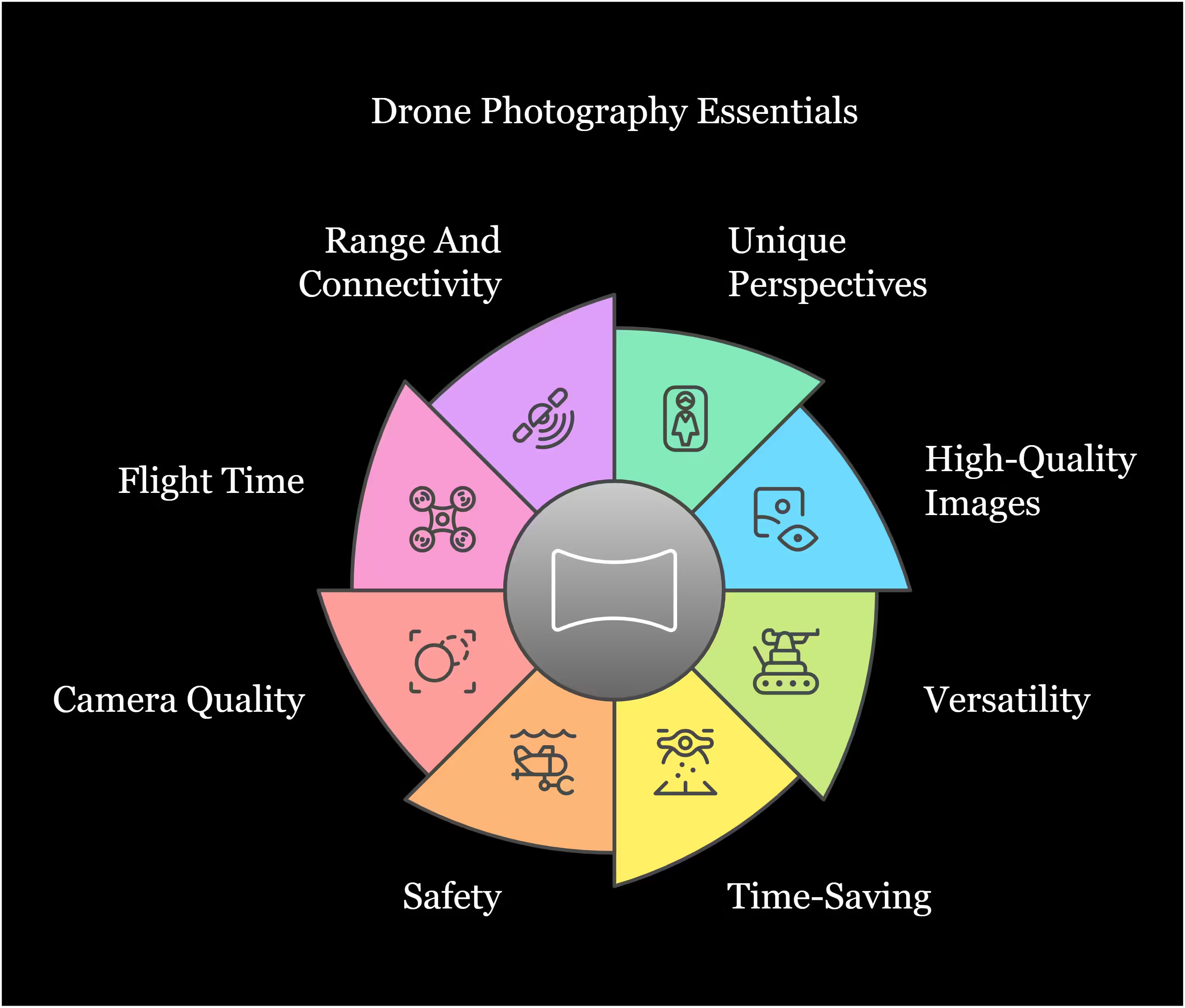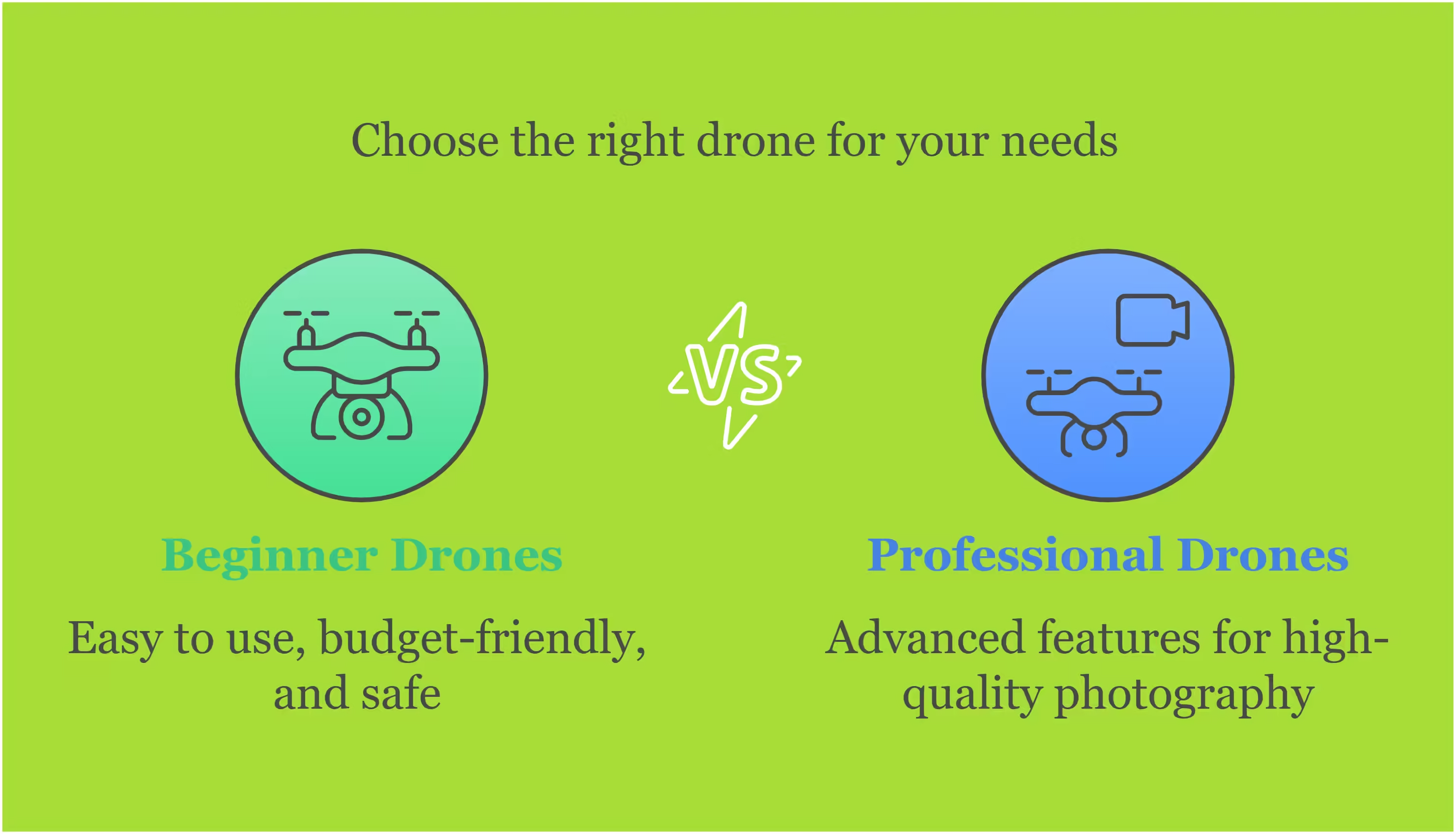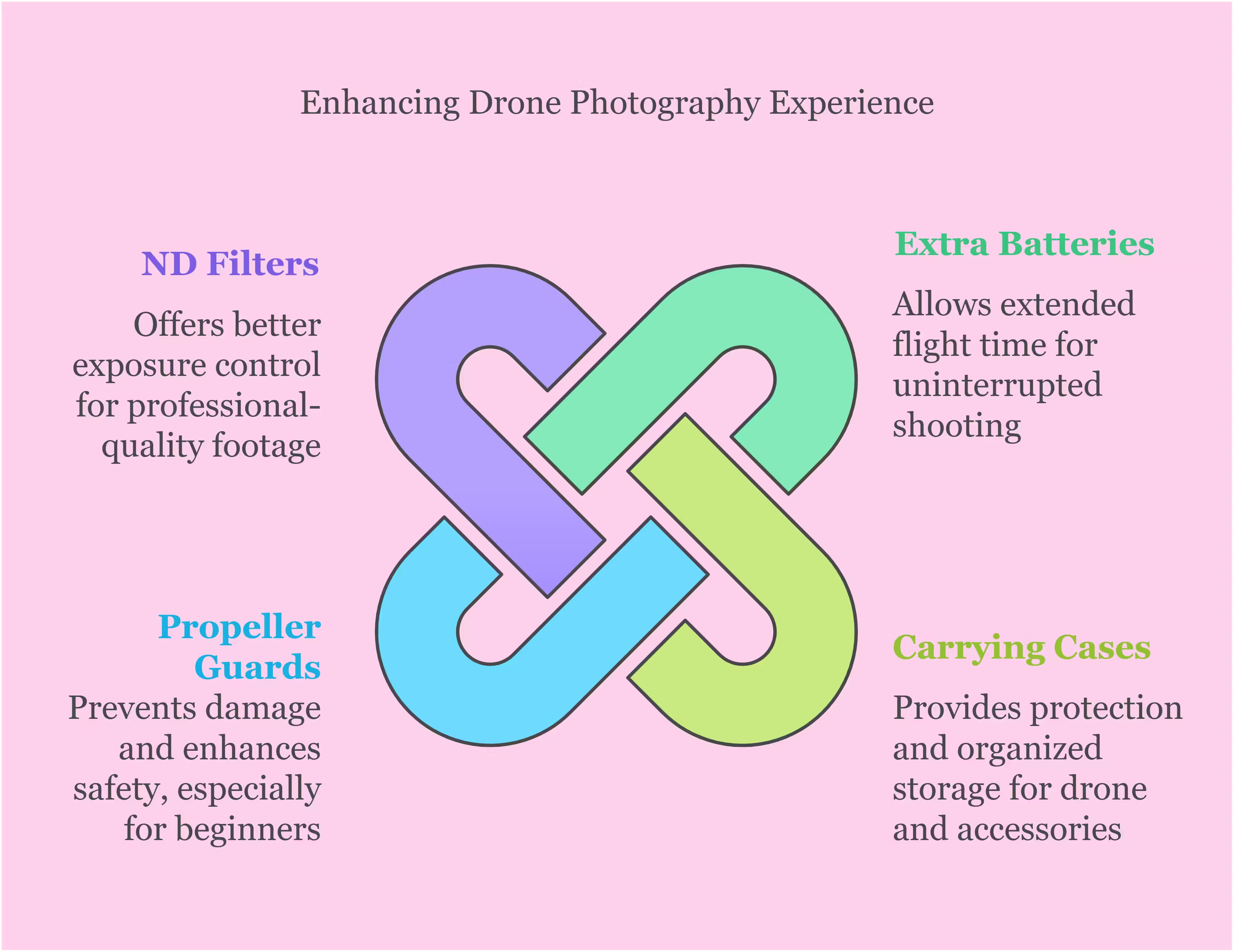Drone Buying Guide for Photographers Choosing the right drone enhances your photography. Consider factors like camera quality, flight time, and ease of use.
Drones have revolutionized photography, offering new perspectives and creative opportunities. High-quality drones now come with advanced cameras, stabilizing gimbals, and intelligent flight modes. Before purchasing, evaluate your photography needs, budget, and skill level. Pay attention to camera resolution, battery life, and portability.
Features like obstacle avoidance and GPS can enhance your shooting experience. Beginner-friendly drones provide ease of use, while advanced models offer more control for professional work. Understanding these factors ensures you invest in a drone that meets your photographic goals. Whether you are a hobbyist or a professional, the right drone can elevate your photography to new heights.
Introduction To Drone Photography
Drone photography has revolutionized the way photographers capture the world. With drones, photographers can access unique perspectives and angles that were once impossible. This guide will help you understand the basics of drone photography and the benefits it offers.
What Is Drone Photography?
Drone photography involves using drones equipped with cameras to take photos from the sky. These unmanned aerial vehicles (UAVs) allow photographers to capture images from heights and angles that ground-based cameras cannot reach.
Drones come with various features, including GPS, stabilizers, and high-resolution cameras. These features make it easier to capture stunning images and videos.
Benefits Of Using Drones
Using drones for photography offers several benefits. Here are some key advantages:
- Unique Perspectives: Drones can capture images from heights and angles that are impossible for ground-based cameras.
- High-Quality Images: Modern drones come with high-resolution cameras, ensuring clear and sharp photos.
- Versatility: Drones can be used in various environments, from urban areas to nature settings.
- Time-Saving: Drones can quickly cover large areas, saving time and effort.
- Safety: Drones can access hazardous areas without putting the photographer at risk.
| Benefit | Description |
|---|---|
| Unique Perspectives | Capture images from heights and angles impossible for ground-based cameras. |
| High-Quality Images | Modern drones come with high-resolution cameras for clear, sharp photos. |
| Versatility | Use drones in various environments, from urban areas to nature settings. |
| Time-Saving | Drones quickly cover large areas, saving time and effort. |
| Safety | Access hazardous areas without risk to the photographer. |
These benefits make drones an invaluable tool for photographers looking to expand their creative horizons.
Key Features To Consider
Choosing the right drone for photography involves various factors. Each feature plays a crucial role in capturing stunning images. Below, we discuss the most important features to consider when buying a drone for photography.
Camera Quality
The camera quality is the heart of any photography drone. Look for a camera with at least 12 MP resolution. Higher resolution means better image clarity. Also, check the sensor size. A larger sensor captures more light and detail. Consider drones with adjustable aperture. This helps in different lighting conditions. Look for drones that support RAW image format. RAW images provide better editing flexibility.
Flight Time
Flight time determines how long you can keep your drone in the air. Most drones offer 20-30 minutes of flight time. Choose a drone with a higher flight time for extended shoots. Some drones come with extra batteries. Extra batteries are useful for longer sessions.
Range And Connectivity
The range of a drone defines how far it can fly from you. For photography, a range of at least 2-3 miles is ideal. This ensures you can capture distant landscapes. Connectivity is crucial for controlling your drone. Look for drones with strong signal strength. Drones with GPS and GLONASS offer better navigation. Ensure the drone supports real-time video transmission. This helps in framing your shots accurately.
Stability And Gimbal
Stability is essential for sharp and clear images. Drones with advanced stabilization features perform better. Look for drones with multiple sensors for steady flights. A gimbal is a device that stabilizes the camera. Choose drones with a 3-axis gimbal. A 3-axis gimbal ensures smooth and stable footage. This feature is especially important for video recording.
Top Drones For Beginners
Starting with drones can be exciting and overwhelming. Beginners need a drone that’s easy to use, budget-friendly, and safe. Here are our top drone picks for beginners.
Budget-friendly Options
Finding a good drone without breaking the bank is essential. Here are a few affordable options:
| Drone Model | Price | Features |
|---|---|---|
| Ryze Tello | $99 | 5 MP camera, 13 min flight time |
| Holy Stone HS100 | $159 | 1080p HD camera, GPS |
| DJI Spark | $250 | 12 MP camera, gesture control |
Ease Of Use
Beginner drones should be simple to fly. Look for features like:
- Auto takeoff and landing: Helps in smooth start and finish.
- Headless mode: Easy to control regardless of the drone’s orientation.
- One-key return: Brings the drone back with one button press.
These features make flying fun and stress-free for new users.
Safety Features
Safety is crucial, especially for beginners. Look for these safety features:
- Obstacle avoidance: Prevents crashes by detecting objects.
- Return-to-home: The drone returns to its starting point if it loses signal.
- Altitude hold: Keeps the drone steady at a certain height.
These features protect your drone and ensure a safe flying experience.
Best Drones For Professional Use
Choosing the best drones for professional use can transform your photography. These drones offer advanced features that can elevate your work. Let’s explore the top choices for professionals.
High-end Models
Professional photographers need high-end drones. These models offer the best features. They come with advanced technology that ensures high-quality photos. Here are some top models:
| Model | Camera Quality | Flight Time | Price |
|---|---|---|---|
| DJI Inspire 2 | 20 MP | 27 minutes | $5,999 |
| Autel Robotics EVO II | 48 MP | 40 minutes | $2,099 |
| Parrot Anafi | 21 MP | 25 minutes | $329 |
Advanced Camera Features
Professional drones come with advanced camera features. These features help capture stunning photos. Look for these key features:
- High Resolution: Ensures detailed photos.
- Stabilization: Keeps the camera steady.
- Zoom Capability: Allows close-up shots.
- Wide-Angle Lens: Captures more of the scene.
These features make a big difference in photo quality. They allow for creative shots that stand out.
Durability And Build Quality
Professional drones must be durable. They should withstand rough conditions. Look for drones with strong build quality. This ensures they last longer.
- Material: High-quality materials improve durability.
- Design: Aerodynamic designs help in windy conditions.
- Crash Resistance: Some drones have built-in crash resistance.
Durable drones save money in the long run. They are a good investment for serious photographers.
Accessories And Add-ons
When purchasing a drone for photography, don’t overlook accessories and add-ons. These items enhance your flying experience and ensure your drone’s safety. Below, we’ll dive into essential accessories for photographers.
Extra Batteries
Extra batteries are crucial for uninterrupted shooting sessions. Most drones have limited flight times, typically between 20-30 minutes. Investing in extra batteries allows you to swap out the depleted ones and continue flying. This is especially useful for long shoots or when traveling to remote locations.
Carrying Cases
A carrying case protects your drone and accessories during transport. Look for cases with padded interiors and compartments for your drone, controller, batteries, and other accessories. A good case minimizes the risk of damage and keeps everything organized.
Propeller Guards
Propeller guards are essential for beginners and indoor flying. They help prevent damage to the propellers and reduce the risk of injury. Propeller guards can be easily attached and removed as needed. They are especially useful in tight or cluttered spaces.
Nd Filters
ND filters (Neutral Density filters) are vital for achieving professional-quality photos and videos. These filters reduce the amount of light entering the camera, allowing for better control over exposure settings. ND filters are especially helpful in bright conditions, enabling smoother and more cinematic footage.
Below is a table summarizing the key benefits of each accessory:
| Accessory | Key Benefits |
|---|---|
| Extra Batteries | Extended flight time, uninterrupted shooting |
| Carrying Cases | Protection during transport, organized storage |
| Propeller Guards | Prevents damage, enhances safety |
| ND Filters | Better exposure control, cinematic footage |
Regulations And Safety Tips
Flying drones for photography is exciting. Yet, it has rules and safety tips. This ensures a safe and legal flight. Below are key points about regulations and safety for drone pilots.
Legal Requirements
Before flying, check the legal requirements in your area. Many countries need drone registration. Drones over a certain weight must be registered. Check the local aviation authority’s website. Follow their guidelines.
Always carry your drone registration certificate. Some areas require a pilot license. Ensure you have all necessary documents. This helps avoid fines and legal trouble.
No-fly Zones
Certain areas are no-fly zones. These include:
- Airports and helipads
- Military bases
- National parks
- Crowded areas
Use apps to check no-fly zones. Respect these areas. This ensures safety for everyone.
Safety Precautions
Follow these safety precautions for safe flying:
- Always inspect your drone before each flight.
- Check the weather. Avoid flying in rain or strong winds.
- Keep your drone within sight at all times.
- Do not fly over people or animals.
- Ensure your drone’s battery is fully charged.
These tips help prevent accidents and ensure a smooth flight.
Maintenance And Care
Taking care of your drone ensures it lasts longer and performs better. Proper maintenance and care keep your drone ready for any photography adventure. Follow these tips to keep your drone in top shape.
Regular Inspections
Inspect your drone before every flight. Check for loose parts and damaged propellers. Make sure the battery is fully charged and in good condition. A thorough inspection helps prevent accidents and malfunctions.
- Check propellers: Look for cracks or bends.
- Inspect motors: Ensure they spin freely.
- Examine the frame: Look for any signs of wear.
- Test the camera: Make sure it is securely attached and functional.
Cleaning Tips
Clean your drone after every flight. Dust and dirt can affect its performance. Use a soft brush to clean the propellers and motors. Wipe the body with a microfiber cloth.
- Remove the propellers: Clean them separately.
- Brush the motors: Use a soft brush to remove dirt.
- Wipe the body: Use a damp cloth for stubborn stains.
- Clean the camera lens: Use lens cleaning solution and a microfiber cloth.
Storage Guidelines
Store your drone in a cool, dry place. Keep it in a case to protect it from dust and damage. Avoid direct sunlight and extreme temperatures.
| Storage Tips | Description |
|---|---|
| Use a case | Protects from dust and physical damage. |
| Avoid sunlight | Prevents overheating and damage. |
| Keep dry | Prevents moisture damage. |
| Store batteries separately | Prevents potential leaks and damage. |
Following these guidelines keeps your drone in excellent condition. Happy flying and capturing stunning photos!
Conclusion And Recommendations
Choosing the right drone can be overwhelming. This guide aims to simplify the process. Let’s summarize the top picks and give final tips.
Top Picks Summary
| Drone Model | Features | Price |
|---|---|---|
| DJI Mavic Air 2 | 48MP Camera, 34-min Flight Time | $1,399 |
| Autel Robotics Evo Lite+ | 1-inch Sensor, 40-min Flight Time | $1,399 |
| Parrot Anafi | 4K HDR Camera, Lightweight | $329 |
Final Tips For Buyers
- Set a budget: Determine how much you can spend.
- Check flight time: Look for drones with longer flight times.
- Camera quality: Choose drones with high-resolution cameras.
- Portability: Consider foldable drones for easy transport.
- Safety features: Look for obstacle avoidance and return-to-home.
These tips will help you pick the best drone. Happy flying!
Frequently Asked Questions
What Features To Look For In A Photography Drone?
When buying a photography drone, consider camera quality, flight time, and stability. Look for drones with 4K resolution and gimbal stabilization. GPS and intelligent flight modes are also essential for capturing stunning photos.
How Much Should I Spend On A Photography Drone?
The cost of a good photography drone ranges from $500 to $1500. Higher-end drones offer better camera quality and advanced features. Budget according to your needs and skill level.
Are Drones Easy To Fly For Beginners?
Yes, many drones come with beginner-friendly features. Look for drones with automatic takeoff, landing, and GPS stabilization. Practice in open areas to gain confidence.
Do Drones Require Regular Maintenance?
Yes, regular maintenance is essential for drones. Check propellers for damage and ensure batteries are in good condition. Clean the camera lens and sensors regularly for optimal performance.
Conclusion
Choosing the right drone can elevate your photography. Focus on features that meet your needs and budget. Research thoroughly and read reviews. Remember, investing in the right drone can significantly enhance your creative potential. Happy flying and capturing stunning images!




